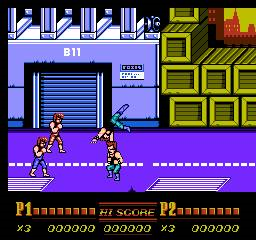
The easy and medium settings end the game after three and eight stages, respectively, while the ninth and final stage can only be reached at the hardest setting. However, the Famicom version allows the entire game to be played on any difficulty setting, whereas the NES version restricts the game's length based on the level chosen. Both versions feature a choice of three difficulty settings at the start of the game. The Family Computer version has a few differences compared to its NES counterpart besides the language change. The intermediate level allows players to complete all but the ninth and final stage the hardest level grants access to all stages and the confrontation with the final boss. Whenever the players defeat one group of enemies, all weapons on the screen disappear, including any that the players are holding.Īt the easiest difficulty level, the game ends after the third stage. Melee weapons have been changed slightly to include chain whips, knives, steel pipes, and grenades. These two moves are performed while the player's character is crouching, which is only possible after landing from a jump or recovering from a fall.Īs in the NES release of Double Dragon, no more than two enemy characters will confront the players at any given time, and they will both be the same type of enemy. In addition to the Cyclone Spin Kick introduced in the arcade version, two additional special moves were added to the player's set of techniques, the Hyper Uppercut and the Flying Knee Kick.
#DOUBLE DRAGON 2 NES WALKTHROUGH FULL#
Unlike the first NES game, the player has full access to Billy or Jimmy's entire repertoire of moves from the beginning. The game retains the directional-based combat system from the arcade version.

Besides the final boss, the other enemy characters that are introduced in this version are the "Right Arm men" (characters based on the villain Jeff from the arcade editions of the first two Double Dragon games) that serve as recurring sub-bosses from Mission 2 and onward, and the ninjas that appear at the end of Mission 2 and later on in Mission 8. The enemy characters are roughly based on the ones featured in the arcade version, but some of them carry different weapons or have new fighting techniques, such as Rowper's ability to throw boomerangs at the player. Before each stage, a cut-scene is shown (similar to the ones in the NES version of Ninja Gaiden) consisting of still imagery and text which provides the setting of the stage. There are a total of nine stages in the NES version.
#DOUBLE DRAGON 2 NES WALKTHROUGH SERIES#
While the first stage loosely resembles the one from the arcade version, the level designs deviates completely from Mission 2 and onward, with scenes set in a variety of new locations such as the interior of a moving helicopter, an undersea base and a series of trap rooms. The structure of the game is completely different. The game offers two modes of play, which differ only in whether or not the two players can hurt each other with their attacks. Unlike the first NES game, Double Dragon II can be played by up to two players simultaneously. The game contains nine stages and three difficulty levels only by choosing the hardest level can the player access all nine stages and see the true ending.Īccording to a North American television commercial by the game's publisher, Acclaim, the NES version of Double Dragon II became a million seller soon after its release.

While this version ignores the plot twist of the first NES game, in which Jimmy Lee turns out to be the final boss (likely due to the inclusion of 2-players co-operative play), it also replaced Willy, the gun-toting gang leader from the arcade version, with a nameless martial artist who wields supernatural abilities as the game's ultimate antagonist.

Players control Billy and Jimmy Lee, who are on a mission to avenge the death of Billy's girlfriend Marian after she is killed during an attack by the Shadow Warriors (an unnamed group in the Japanese version). The NES version of Double Dragon II was directed by Hiroyuki Sekimoto (co-director of River City Ransom), with the arcade version's director Yoshihisa Kishimoto taking a supervisory role in the game's development. The game shares its title with the 1988 arcade sequel to the original Double Dragon, using the same promotional artwork for its packaging and having a similar plot, but the content of the two games are otherwise drastically different. It is the second Double Dragon game for the NES and was published in North America by Acclaim Entertainment, who took over publishing duties from Tradewest. Double Dragon II: The Revenge is a side-scrolling beat-'em-up produced for the Nintendo Entertainment System in the end of 1989.


 0 kommentar(er)
0 kommentar(er)
